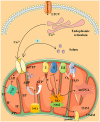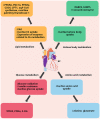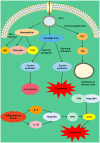Sepsis‑induced cardiac dysfunction and pathogenetic mechanisms (Review)
- PMID: 37859613
- PMCID: PMC10619129
- DOI: 10.3892/mmr.2023.13114
Sepsis‑induced cardiac dysfunction and pathogenetic mechanisms (Review)
Abstract
Sepsis is a manifestation of the immune and inflammatory response to infection, which may lead to multi‑organ failure. Health care advances have improved outcomes in critical illness, but it still remains the leading cause of death. Septic cardiomyopathy is heart dysfunction brought on by sepsis. Septic cardiomyopathy is a common consequence of sepsis and has a mortality rate of up to 70%. There is a lack of understanding of septic cardiomyopathy pathogenesis; knowledge of its pathogenesis and the identification of potential therapeutic targets may reduce the mortality rate of patients with sepsis and lead to clinical improvements. The present review aimed to summarize advances in the pathogenesis of cardiac dysfunction in sepsis, with a focus on mitochondrial dysfunction, metabolic changes and cell death modalities and pathways. The present review summarized diagnostic criteria and outlook for sepsis treatment, with the goal of identifying appropriate treatment methods for this disease.
Keywords: ferroptosis; metabolic change; mitochondrial dysfunction; sepsis; signaling pathway.
Conflict of interest statement
The authors declare that they have no competing interests.
Figures



Similar articles
-
Mitochondrial Mechanisms in Septic Cardiomyopathy.Int J Mol Sci. 2015 Aug 3;16(8):17763-78. doi: 10.3390/ijms160817763. Int J Mol Sci. 2015. PMID: 26247933 Free PMC article. Review.
-
New developments in the role of ferroptosis in sepsis‑induced cardiomyopathy (Review).Mol Med Rep. 2025 May;31(5):118. doi: 10.3892/mmr.2025.13483. Epub 2025 Mar 7. Mol Med Rep. 2025. PMID: 40052561 Free PMC article. Review.
-
Pathogenetic mechanisms of septic cardiomyopathy.J Cell Physiol. 2022 Jan;237(1):49-58. doi: 10.1002/jcp.30527. Epub 2021 Jul 18. J Cell Physiol. 2022. PMID: 34278573 Review.
-
Cardiomyocyte death in sepsis: Mechanisms and regulation (Review).Mol Med Rep. 2022 Aug;26(2):257. doi: 10.3892/mmr.2022.12773. Epub 2022 Jun 15. Mol Med Rep. 2022. PMID: 35703348 Free PMC article. Review.
-
[Research progress on the mechanism of ferroptosis in septic cardiomyopathy].Zhonghua Wei Zhong Bing Ji Jiu Yi Xue. 2022 Oct;34(10):1107-1111. doi: 10.3760/cma.j.cn121430-20220823-00776. Zhonghua Wei Zhong Bing Ji Jiu Yi Xue. 2022. PMID: 36473574 Review. Chinese.
Cited by
-
Macrophage Notch1 drives septic cardiac dysfunction by impairing mitophagy and promoting NLRP3 activation.Biol Direct. 2025 May 26;20(1):65. doi: 10.1186/s13062-025-00657-4. Biol Direct. 2025. PMID: 40414862 Free PMC article.
-
Sepsis in elderly patients: investigation of prognostic factors in a secondary healthcare facility.BMC Infect Dis. 2025 Jul 10;25(1):907. doi: 10.1186/s12879-025-11286-7. BMC Infect Dis. 2025. PMID: 40640725 Free PMC article.
-
Bioinformatics study of the TNFRSF1A mechanism involved in acute liver injury in sepsis through the mTOR signaling pathway.Histol Histopathol. 2025 Mar;40(3):401-409. doi: 10.14670/HH-18-789. Epub 2024 Jul 3. Histol Histopathol. 2025. PMID: 39044690
-
PANoptosis in Sepsis: A Central Role and Emerging Therapeutic Target.J Inflamm Res. 2025 May 13;18:6245-6261. doi: 10.2147/JIR.S513367. eCollection 2025. J Inflamm Res. 2025. PMID: 40386177 Free PMC article. Review.
-
Wogonin attenuates septic cardiomyopathy by suppressing ALOX15-mediated ferroptosis.Acta Pharmacol Sin. 2025 Apr 9. doi: 10.1038/s41401-025-01547-1. Online ahead of print. Acta Pharmacol Sin. 2025. PMID: 40205009
References
-
- Hammond N, Kumar A, Kaur P, Tirupakuzhi Vijayaraghavan BK, Ghosh A, Grattan S, Jha V, Mathai D, Venkatesh B, Sepsis in India Prevalence Study (SIPS) Investigator Network Estimates of sepsis prevalence and outcomes in adult patients in the ICU in India: A cross-sectional Study. Chest. 2022;161:1543–1554. doi: 10.1016/j.chest.2021.12.673. - DOI - PubMed
-
- Shankar-Hari M, Phillips G, Levy ML, Seymour CW, Liu VX, Deutschman CS, Angus DC, Rubenfeld GD, Singer M, Sepsis Definitions Task Force Developing a new definition and assessing new clinical criteria for septic shock: For the third international consensus definitions for sepsis and septic shock (sepsis-3) JAMA. 2016;315:775–787. doi: 10.1001/jama.2016.0289. - DOI - PMC - PubMed
-
- Bone RC, Balk RA, Cerra FB, Dellinger RP, Fein AM, Knaus WA, Schein RM, Sibbald WJ. Definitions for sepsis and organ failure and guidelines for the use of innovative therapies in sepsis. The ACCP/SCCM consensus conference committee. American college of chest physicians/society of critical care medicine. Chest. 1992;101:1644–1655. doi: 10.1378/chest.101.6.1644. - DOI - PubMed

